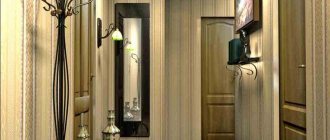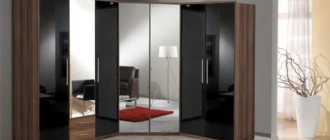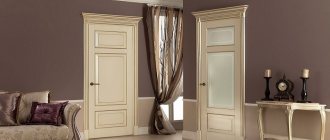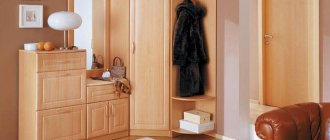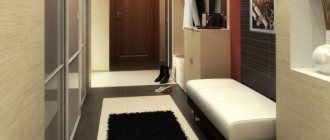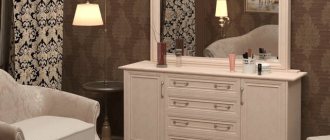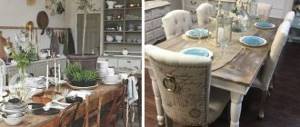The living space of modern apartments simply must be useful and functional; in addition, everyone wants comfort and order to always reign in their home. Such pieces of furniture for storing clothes and linen, such as wardrobes, chests of drawers, various cabinets and shelves, would seem vitally important in any home. But they often require too much space. A dressing room will help you rationally organize your living space. Interesting photos, modern projects, creative finds and advice from professionals can be useful when developing a dressing room design for your apartment.
What is a dressing room for?
Wardrobe rooms are designed for organized storage of clothes, shoes and accessories. The presence of such a specialized room will free up the space of a house or apartment from unnecessary things and furniture, giving them greater comfort.
- A well-thought-out dressing room arrangement provides many advantages:
- You can use the entire space - from floor to ceiling.
- Clothes and shoes are hidden from prying eyes.
- Plenty of storage space.
- Each thing has its place, and at the same time they are all in sight.
- You can plan your dressing room and select equipment for internal filling individually, depending on the existing conditions. For example, use unused space in the house under the stairs or part of the corridor.
- A good location and beautiful external design (doors, mirrors, lighting) will visually improve the room and hide unsightly protrusions, beams, and uneven walls.
Wardrobe rooms can be appropriate in both small and large rooms. We will consider examples of various room layouts for storing outerwear, hats, shoes, and linen in more detail.
By hallway size
The dimensions of dressing rooms for hallways directly depend on the free space. They can be small, or they can be a whole dressing room. Let's look at a few of their features.
Small wardrobe
If you have a standard-sized apartment, in which the hallway is not very large, you can arrange a dressing room with an area of 4-5 m2. For residents of 2-3 people this is quite enough. With minimal dimensions, the dressing room in the hallway is reduced to an area of 2 m2, which by and large is no different from a regular wardrobe. The main thing is to rationally distribute the space.
Basic tips for organizing a small wardrobe:
- It is better to place it near the wall with the largest area.
- To save space, sliding doors are installed, preferably from floor to ceiling.
- The interior is filled with shelves, rails, shoe racks, baskets and boxes.
- Be sure to make sure that not a single square centimeter goes unnoticed.
- The shelves are placed right up to the ceiling. For ease of use, carry a stepladder.
If the design of the room allows, then you can also arrange a corner wardrobe in the hallway. The simplest option is to fence off the corner with a plasterboard partition and then install sliding doors. The shelves are mounted directly to the walls. This design has a triangular shape.
Let us also note the simplest option - an open mini-wardrobe. Occupies a small space near the door. Consists of a minimum of elements: a shelf for shoes, a rail with hooks and an upper shelf for hats.
Large wardrobe
In the case where there is a lot of free space in the hallway, a large dressing room is arranged. To do this, a wall is built from a plasterboard partition and a door is installed in the opening. Within the allotted space, you can experiment and distribute shelves, drawers and hanging rods at your discretion.
Related article: Which wardrobe to choose: types and design features
But to make everything look modern, it is recommended to listen to the opinions of experts:
- For a large dressing room, several rods are installed to store clothes on hangers. Their placement is carried out at different levels.
- The more drawers you can arrange, the better. They can be decorated in a different color. Recently, the arrangement of wicker or plastic baskets has become very popular.
- Shelves are an indispensable attribute. There should be a lot of shelves in the dressing room.
- To place shoes, there is a compartment that is narrow and high in appearance. It's called a pencil case. Shelves are installed directly in it.
- We should not forget about the placement of ties, scarves and other accessories.
- The highlight of the dressing room is the full-length mirrors and the presence of a soft pouf for convenience.
Wardrobe placement options
- Depending on the availability of free space, the dressing room can be located:
- in the hall;
- in the corridor;
- in the room;
- in the bedroom;
- in the pantry.
Dressing room in the room
A small wardrobe for storing a large number of things can be equipped even in a modest-sized room. The smallest dressing rooms have dimensions of 1x2.0 and 1x2.5 m.
In such a space of 2 to 3 square meters you can fit drawers, hangers and a rack, and decorate the free wall with a functional mirror sheet.
Features of the wardrobe in the bedroom
When there is no separate free space, a storage room can be arranged in the bedroom.
If the size of the bedroom allows, then you can allocate space along one of the walls for a storage area, dividing the space with a partition or sliding doors.
The role of such a partition can be performed by a high rack with a passage or a cabinet the entire height of the room. Between the structures, as a rule, a little free space is left, which is later used for changing clothes.
In a bedroom of a non-standard shape, the correct location of the dressing room will improve the geometry of the room: visually expand the room that is too long and narrow, hide the presence of niches or protrusions.
Design of a dressing room in the hallway
The most successful option would be to place a dressing room in the hallway, if the dimensions of the room allow.
If the hallway has the shape of an elongated rectangle, then the most appropriate option would be a wardrobe built along one of the walls.
This arrangement will allow you to use maximum space for storing a large volume of things, and sliding or folding doors (photo) with mirror filling will visually expand the space of the hallway.
Interior of a dressing room in the hallway
There are different ways to place a dressing room in a hallway or hallway. It all depends on the size and design project.
A dressing room can consist of an open or closed shelving and cabinet, mezzanines, drawers, special shelves for shoes and other elements.
Even in the narrowest hallways, it is possible to place a dressing room with sliding doors if you make it of a non-standard depth: not 60 cm, but only 40 cm.
If a large corridor has an irregular shape, using plasterboard walls you can divide the space into two rooms, one of which will become a dressing room.
If there is an empty niche that can be filled with narrow side shelves, mezzanines, lower drawers and metal rods, it will become an excellent alternative to an expensive wardrobe that simply has nowhere to put it.
Dressing room in the pantry
Even in very small apartments, where there is no question of a special room for clothes, there is a space reserved for a pantry or closet. If you wish, you can easily turn it into a comfortable dressing room with your own hands.
To do this, you will need to clear the room of trash and extra shelves, install holders for things and install lighting.
A mini-wardrobe with access to the corridor is recommended to be used for outer and seasonal clothing, out-of-season shoes, and bags. This will help relieve space in living rooms. This solution is also preferable from the point of view of hygiene rules.
Having a larger storage area opens up wide planning possibilities, but requires a thoughtful approach to the arrangement of storage systems. It is also very important to take care of sufficient ventilation of the room, protecting things from moisture, insects, animals and foreign odors.
Hallway design with dressing room
Everyone wants to have a spacious hallway with a convenient dressing room. But this is not always real. When creating an interior, you have to start from what you have. There are several design options for hallways with a dressing room. Ideas can be viewed in the photos below.
In addition to the structure and shape of the dressing rooms, their design is important, which can be supplemented by the following variations:
- accessories, the variety of which is not decently large;
- the presence of mirrors with different decorations;
- variety of lighting: spotlights, LED lighting, etc.
There are quite a lot of examples. You can view them on the Internet in photos and, if desired, create your own individual project. You can also contact designers who will definitely give practical advice.
What to consider when choosing a dressing room and wardrobe (2 videos)
Different wardrobe options (60 photos)
Long Corridor Design, 96 Photos – This House regarding Corridor Renovation Photo – Gooberzz
Execution of dressing rooms
Depending on the allocated free space, the dressing room can be placed:
- in the corner of the room;
- in any free part of the room (built-in option).
Corner dressing room
Corner dressing rooms are very functional, occupy a minimum of space and, compared to a conventional linear arrangement, make it possible to store twice as much stuff.
The corner structure, made in a modern design, will look very stylish and will become a real highlight in the overall interior of the room.
The corner option for placing storage systems is optimal for owners of small apartments; it allows you to effectively use space in rooms with limited space - bedrooms, hallways, children's rooms, attics.
You can separate the dressing room using sliding sliding doors - both standard and radius (semicircular). For high rooms, partitions with a doorway made of plywood or plasterboard, as well as various screens or curtains, are suitable.
Built-in wardrobe
A built-in dressing room is a universal design for storing things and clothes, as well as a convenient place for changing clothes. The variety of possible cabinet configurations allows you to create any interior to suit your taste.
- There are three basic elements of built-in furniture:
- wardrobes;
- wardrobes;
- partially built-in wardrobes.
The functional elements of the dressing room will allow you to organize convenient and comfortable storage of things. In addition to the usual shelves and drawers, all kinds of rods, hangers, shoe racks, and special devices for storing trousers and ties are used.
Modern equipment with gas elevators and brackets provides easy access to things and allows you to use every centimeter of space.
Sliding doors, decorated in accordance with the style of the room, significantly save and decorate the space of the apartment.
Small dressing room
Even in a small area, you can install vertical pull-out cabinets for outerwear, place shelves and cabinets for linen, and reserve the bottom rows for shoes.
It is worth noting that when equipping a storage system in a mini-wardrobe, it makes sense to abandon the use of frame structures. All internal elements - shelves, racks and rods must be attached directly to the walls. This significantly saves internal space.
Built-in dressing room in the hallway
Built-in wardrobes: how to install correctly
A built-in wardrobe is the most modern and best option for storing clothes and shoes. If you have empty niches in your home, you can fill them with built-in wardrobes. Then you will not only get a place to store things, but also save some space. In addition, a wardrobe system built into a niche is a modern interior option, which means you will not lag behind fashion.
Built-in dressing room in the hallway: how to place it
Most often, wardrobe systems are placed in the hallway. In order to do this correctly, you must follow a number of recommendations.
How to properly place a dressing room in the hallway:
- The air in your hallway should be as dry as possible, since humid air has an adverse effect on clothing;
- For a dressing room, the best place would be a corner, an empty niche and other similar nooks and crannies in the room;
- Make sure that your dressing room has space for both hangers (to hang jackets, coats, etc.) and shelves;
- Color. It should combine, blend in, or, on the contrary, create a contrast with the rest of the design of your room.
- Dressing room facade. In the case of a built-in dressing room, you only see the facade, which can be made of glass, wood, plastic or mirror. The last option is in greatest demand, since it will increase the space in the room not only due to the fact that the dressing room is a built-in type, but also visually, with the help of a mirror.
- Inner space. The location of sections, shelves, their sizes, quantity and location (in modern versions there are often chaotically located shelves, while in the more traditional version everything is evenly spaced to each other). Also consider whether you will be hanging outerwear in this wardrobe, and if so, make sure there is enough hanging space for your entire family's clothes.
- Remove everything unnecessary from the pantry and clean it of possible dirt and dust;
- If the walls in the closet do not have a flat surface, which is most often the case in practice, then level them;
- Also level the floor and then cover it with parquet, linoleum or other covering;
- Tidy up the ceiling. This can be done using wallpaper, lining or plastic.
- Now you can start arranging your dressing room.
- Mirrors on the doors of the dressing room. The most versatile way to visually expand a room.
- Stained glass inserts. They will not suit every interior, but with the right approach it looks elegant.
- Glass facades with photo printing applied to them. It is also considered a modern option, suitable for any interior.
- Complex assembly, which in most cases can only be done by professionals.
- A built-in dressing room cannot be moved, since it is adjusted exactly to the size and curvature of the walls to which it will be attached, and the possibility that it will fit other surfaces is negligible.
- Built-in furniture spoils the walls, since it is attached to them using fastening materials such as self-tapping screws, dowels, etc.
- rods and pantographs;
- hangers for trousers (pull-out);
- boxes;
- shelves;
- baskets, boxes;
- shoe storage systems;
- hangers for accessories (ties, umbrellas, belts, etc.);
- sections for storing household equipment (mops, vacuum cleaners, brooms, etc.).
The dressing room must have ventilation
In order to save as much space as possible, make shelves in your dressing room up to the ceiling. Place clothes that are less used this season on the top shelf (in summer, for example, you can put winter shoes there), and if necessary, place a chair.
Where to place a built-in wardrobe
In fact, the best place for a built-in wardrobe would be any empty corner in the room. A space of two by two meters will be enough to fit a wardrobe for the whole family. The main thing is to take a place up to the ceiling.
Sometimes a place is allocated for built-in dressing rooms in an old storage room, on a balcony or loggia. In general, choose a place that is empty in your house.
A built-in wardrobe can be installed in absolutely any room
By the way, with proper planning of the room design, a built-in wardrobe can become both the highlight of the room and merge with the walls so that it is not visible. Here it’s worth starting from personal preferences and the nuances of the room.
How to choose a built-in wardrobe design
As is the case with conventional wardrobes, the modern market offers the buyer a wide selection of built-in wardrobes, different in both size and design.
What to consider when choosing a built-in wardrobe:
The choice of color option for your dressing room will depend only on your own preferences.
These three points are the main ones in dressing room design. Another important parameter when choosing is the cost of the dressing room. It depends primarily on the design and size of the cabinet.
Before you start choosing a wardrobe, accurately measure the space allocated for it, and choose based on these parameters.
Wardrobes built into a niche: advantages
If the architecture of your home provides a niche, then this is even better for a wardrobe: you don’t have to take up a balcony or an extra corner in the room.
Please note that when installing in a niche, the main parameters when choosing a dressing room will be the dimensions of the niche itself. Ideally, the cabinet should fit exactly into the allotted space.
A dressing room located in a niche will not take up much space and will save a significant part of the living space
Therefore, if you have a niche at home, then adapt it to the built-in dressing room. Small niches are not suitable for dressing rooms, as they will be filled very quickly.
Built-in wardrobe systems: how to remodel a pantry with your own hands
Another popular place for a built-in wardrobe system is an unnecessary pantry, which will take very little time to remodel.
How to convert a storage room into a dressing room:
Even a small storage room can make a wonderful dressing room
If the storage room was wide enough, then in the future dressing room you can even change clothes, so take care of a high-quality floor.
Built-in wardrobes and dressing rooms: how to save space
If you choose a built-in dressing room to save space in the room, then you should know a number of nuances that will also help visually expand your bedroom.
By installing a mirror on the facade of the dressing room, you will not only visually expand the room, but also get a practical thing
How to save space with a dressing room:
Convenient option: built-in wardrobes (video)
As you can see, a built-in dressing room is not only a modern, but also an economical solution for furnishing an apartment. You can place furniture in such dressing rooms. And the wide variety of options offered by the market will allow you to find the best option for you.
Design of built-in wardrobes (photo examples)
Design of a wardrobe in the hallway
An integral part of any home is the hallway. As a rule, this is a small room, the interior of which plays a significant role in shaping the impression of the owner of the apartment. After all, it is the hallway that visitors see first when they enter the apartment. Therefore, its arrangement must be done thoughtfully and competently.
An interesting and rational design solution is the location of a dressing room in the hallway, which replaces everyone’s boring ordinary wardrobe. And currently this trend is becoming more and more popular in our country.
Advantages and disadvantages of a built-in dressing room in the hallway
When creating built-in furniture, craftsmen calculate its dimensions in such a way that all parts of the body fit perfectly to the walls, floor and ceiling. As a result, there are no inaccessible places where dust can accumulate for years, as is the case with cabinet furniture. In addition, this type of furniture creates the impression of a monolithic structure, which looks modern and aesthetically pleasing.
The cost of built-in furniture is lower than the cost of cabinet furniture. This happens by reducing the amount of materials for its manufacture. So, for example, when building a sliding wardrobe into a niche, there is no need to create an external frame; in this case, they usually get by with installing only sliding doors throughout its entire opening. In addition, you can significantly save on filling a built-in wardrobe by partially or completely creating it yourself.
Built-in furniture is more stable. During its operation, the possibility of overturning or displacement is completely excluded.
If the structure of the room is complex (beveled corners, the presence of beams, partitions, etc.) or its non-standard dimensions, it is possible to install only built-in furniture, because cabinet products almost always have a rectangular shape, and in this case it is unlikely to be able to select them according to size .
A built-in dressing room helps to save not only money, but also free space, because it is installed between the walls, as well as the floor and ceiling. This factor is especially important when installing a dressing room in the hallway, which most often has a small area. As for the cabinet analogue, in this case there is always a gap between its outer frame and the walls of the room, that is, there is an irrational use of free space.
Built-in furniture contributes to the visual alignment of the floor, ceiling and walls of the room in which it is installed. Cabinet furniture, on the contrary, due to its rectangular shape, as well as the angles of fastening of parts equal to strictly 90 degrees, focuses attention on even the slightest irregularities.
But built-in furniture also has disadvantages. These include:
Wardrobe options for the hallway
There are a huge variety of dressing room design options, this applies not only to the appearance, but also to its functional parts.
Dressing room with hinged doors
This look is perfect for a classic hallway interior. The size of such a wardrobe depends entirely on the availability of free space. This piece of furniture can be given an interesting look by using a variety of fittings.
As for functionality, it usually has three compartments. The lower compartment is used to store shoes, the middle one is the largest, to store outerwear, and the top one is used to store hats.
The “disadvantage” is that with a narrow hallway, hinged doors are inconvenient to use.
Dressing room in the hallway with sliding doors
This option is the most popular today. After all, it saves space, since it is attached directly to the walls, does not create interference in the form of open doors, and accommodates large items.
In most cases, this type of wardrobe is installed along one wall of the hallway. Its length depends on the length of the wall to which it will be attached, and its width depends on the size of the corridor. But even in the narrowest hallways, it is possible to place a dressing room with sliding doors, only its width will not be 60 cm, which is the standard, but only 40 cm.
Dressing room with open shelves
Of course, most often people try to hide the contents of their wardrobe with doors, but there are also those who love open spaces, as well as airy interiors, so they refuse doors and install wardrobes with open shelves.
This design may involve the complete or partial absence of façade details. If the installation of facades is not intended, then the entire dressing room consists only of dividing walls and shelves.
In cases where there are no fronts, the central shelves and hooks for outerwear remain only partially open, and the uppermost and lower compartments are closed with doors. To store small items in such cabinets, special wicker baskets and interior boxes are used. Also, in this kind of dressing room there is usually a seat running along the entire structure, which is quite convenient, especially in small rooms.
Corner dressing room for the hallway
If the hallway has a large area, you can install a corner dressing room, which will fit all the family things.
Inside such structures there is an extensive storage system, which may include hooks, shelves, drawers, etc.
To ensure that the structure does not look too massive, both open and closed areas are provided when creating it.
A corner wardrobe in the hallway is an excellent alternative to a separate dressing room.
Dressing room in the hallway niche
The owners of a hallway with a niche are very lucky, because the dressing room can be located in it and thereby not violate the integrity of the space of the room itself.
Advice. If you paint the side wall of the dressing room the same color as the walls of the hallway itself, you can get the effect of a niche. Currently, this design move is becoming increasingly widespread.
Material for the facades of the dressing room in the hallway
Currently, there are practically no restrictions on the material that will be used for facades. Furniture manufacturers can offer both the most presentable and expensive materials, as well as the most budget options. The facades of the dressing room can be made of MDF, laminated chipboard, natural wood, perforated metal, glass, mirrors, etc. Facades that combine several types of materials look great, for example, a dressing room with a combination of doors with a mirror and photo wallpaper looks original.
Advice. Remember that mirrors and light colors visually enlarge the space, while dark shades, on the contrary, narrow it, so only owners of light, spacious hallways can afford dark facades for a dressing room.
Dividing the interior space of the dressing room
In order to organize the storage of things and increase the usability of the dressing room, it is necessary to zoning it. Usually there is a storage area for each family member and one common area for shared items. Thoughtful and pre-planned zoning eliminates the irrational use of space.
When it comes to filling out the dressing room, there are many options regarding design and functionality. The design of the system can be made in a modern style using metal structures, or perhaps in a classic design: with wooden shelves, rods, etc.
As for the functionality of the dressing room, there are now a large number of tools that will make storing things easier and more organized. Such means include:
Recommendations for filling the dressing room in the hallway
The video shows a wardrobe option with sliding doors:
Discuss the article on the forum
Dressing room in the hallway: design options
The dressing room should be made in the same style as the interior of the hallway. A dressing room is the dream of most modern girls, and even some men. Having this space in your home allows you to store all your clothes in one place. However, unfortunately, not all apartments have enough rooms to devote one of them entirely to a wardrobe, so you often have to combine this storage system with other areas. A bedroom, living room or corridor are those rooms that are often combined with a wardrobe, but with a little imagination, you can easily build an entire dressing room, for example, into a hallway.
Dressing room in the hallway
If you are the happy owner of a large hallway or irregularly shaped corridor, you can simply use a plasterboard wall with a door to divide the space into two rooms, one of which will become a dressing room.
Depending on your desires and capabilities, you can buy a clothing storage system or make it yourself.
You can hide the dressing room in the hallway using sliding doors or curtains
If you buy ready-made wardrobes, then choose open-type storage for such wardrobes, as they visually expand the space. It is not necessary to decorate a large dressing room in exclusively light colors; a combination of black and white will look stylish.
What should be in a spacious dressing room:
When decorating the inside of dressing rooms, give preference to functionality, but do not forget about beauty.
Corner dressing room in the hallway
For those whose hallway is not particularly large, a corner placement of the dressing room is suitable. Of course, such a room will have a fairly modest area, but with the right design project, you can place the clothes of all family members in it.
Among the advantages of a corner dressing room, compactness and good aesthetic qualities should be noted
A corner dressing room is the only option for creating a full-fledged space for storing clothes in a one-room apartment with a small corridor.
When decorating such a small room, you should think through everything down to the smallest detail, because any, even the most insignificant, mistake can significantly reduce the capacity of the corner dressing room.
Making a corner dressing room with your own hands:
It is not necessary to separate the hallway from the room for storing clothes and shoes with a plasterboard wall; you can simply cover it with a translucent screen.
Wardrobe in the hallway
If for some reason you cannot fit even a small corner dressing room in the hallway, you can use a spacious wardrobe. It will fit both outerwear and everyday wardrobe. Also, a corridor with a wardrobe system can be supplemented with a narrow and high shoe cabinet with folding doors. A closet, the function of which is to store the clothes of all family members, must have a large number of compartments and be of sufficiently large size. Especially good, such furniture will fit into the space of a long and narrow corridor.
For convenience, it is recommended to equip the wardrobe with several lamps
What a wardrobe should include:
- Shelves for storing folded clothes;
- Two compartments with rods for hangers (one for storing outerwear, the other for dresses, skirts, shirts and trouser suits);
- Drawers or organizers for storing underwear and socks;
- Compartment for hats;
- Hangers for belts and scarves;
- Place for umbrellas and bags;
- Sliding doors with full length mirror.
The closet, of course, does not have the same functionality as a full-fledged dressing room, however, with the right configuration, it can fit most of your things.
Small dressing room in an open hallway
In addition to the closet, hallways with deep niches can be equipped with a built-in open-type wardrobe system. They can accommodate a large number of shelves, and if the layout of the hallway involves the presence of not one, but several recesses in the wall, you can also place metal pipes for hangers there.
A small open wardrobe built into the wall fits perfectly into the hallway, which is made in high-tech style
The color of each niche may be different; the contrasting finish of such a system looks especially unusual.
In narrow and long corridors, to increase space, windows leading to other rooms are often cut; in these windows you can also make a hanging clothing storage system. The ensemble of built-in wardrobe furniture can be supplemented with a spacious open-type cabinet with storage compartments for shoes and a soft seat and a large full-length mirror located on its surface.
Compact dressing room in the hallway (video)
A dressing room is convenient and modern; if you are not able to allocate a whole room for such storage, then take a closer look; most likely, there is a corner in your apartment where you can easily fit a clothing storage system of one of the described types.
Details: dressing room in the hallway (photo examples)
- Banquettes with storage drawers - beauty at the service of practicality in your hallway The need to constantly find storage places for various things is typical for a home with a small area. Methods...
- Shoe racks, cabinets, cabinets and other furniture for storing boots and shoes in the hallway In a modern interior, it is customary to think through everything to the smallest detail. You can’t luxuriously furnish a room and forget about...
- Dressing room in a one-room apartment Photo of a dressing room in an apartment Ideally, a dressing room is a separate room that combines the functions of a spacious…
- Ceiling chandelier for the hallway Aldo Bernardi Almerich Ambiente Antonio Ciulli Archeo Venice Design Arlight ArtClassic Arte Lamp Artemide Artpole…
Wardrobe room layout
- Ideally, the dressing room space should be divided into 4 functional zones:
- wardrobe for storing outerwear;
- smaller wardrobes for short items (jackets, men's shirts, blouses and skirts;
- shoe module;
- changing area (well lit with a mirror).
The arrangement of a dressing room always begins with a drawing and design project, in the preparation of which it is important to take into account everything down to the smallest detail: the dimensions of the future dressing room, the materials used, the design style, the internal content and the type of lighting.
Preview and sort all your items. You can make a catalog to calculate which shelves should be more and which ones should be smaller.
Sections should be of different sizes depending on their purpose. There should be more places where you can place things on hangers in a straightened form than there are shelves and drawers. They must make up at least 75% of the total filling volume. The standard depth for such sections is 60 cm.
The optimal depth for standard shelves is 30-40 cm.
Doors to the dressing room
Doors for wardrobes can be divided into three types according to their design. The choice will depend on the size and location of the room.
- Doors are hinged. It can be used if the apartment has a lot of space and a separate room is allocated for a dressing room. They take up a lot of space, but fit perfectly into the overall interior of the apartment.
- Accordion doors. Perfect if the dressing room is built-in in the hallway or in the room.
- Sliding doors. Sliding doors that go into the wall or move inside the doorway. When every meter of space counts, they will provide comfortable and really quick access to the room with clothes. They take up the least space, but their installation is quite complicated.
Any type of door can be made interesting by using different decors.
Transparent or wooden, classic or hi-tech - the doors must match the overall interior and add an element of unusualness to it.
- The most current ideas:
- the sliding door is half made of frosted glass or plastic and half covered with wallpaper or fabric;
- bamboo door;
- glass door with stained glass;
- mirror door with or without a pattern;
- Japanese screen door.
Wardrobe in the hallway
If for some reason you cannot fit even a small corner dressing room in the hallway, you can use a spacious wardrobe. It will fit both outerwear and everyday wardrobe. Also, a corridor with a wardrobe system can be supplemented with a narrow and high shoe cabinet with folding doors. A closet, the function of which is to store the clothes of all family members, must have a large number of compartments and be of sufficiently large size. Especially good, such furniture will fit into the space of a long and narrow corridor.
For convenience, it is recommended to equip the wardrobe with several lamps
What a wardrobe should include:
- Shelves for storing folded clothes;
- Two compartments with rods for hangers (one for storing outerwear, the other for dresses, skirts, shirts and trouser suits);
- Drawers or organizers for storing underwear and socks;
- Compartment for hats;
- Hangers for belts and scarves;
- Place for umbrellas and bags;
- Sliding doors with full length mirror.
The closet, of course, does not have the same functionality as a full-fledged dressing room, however, with the right configuration, it can fit most of your things.
Filling the dressing room
In most cases, the internal contents of a dressing room are made to order by specialists. However, furniture stores keep an eye on new products and also offer many options for components, so you can assemble the parts yourself.
- The standard set usually includes:
- racks;
- multi-level rods of different lengths;
- shelves;
- boxes;
- baskets or sealable containers;
- brackets for ties and belts;
- compartments for short clothes;
- shoe module;
- set of hooks and rods.
In conditions of limited space in corner wardrobes, you should plan the largest possible number of open and shallow shelves. However, the project should provide closed drawers for storing underwear, bed linen, and towels.
If space allows, the dressing room should also accommodate:
- mirror;
- pouf;
- retractable or foldable ironing board
- iron.
Shelves for dressing room
These parts can be fixed or retractable. The width of the shelf usually varies between 30-40 cm. For mezzanines, you can use shelves up to 60 cm wide.
Mobile shelves can be folding or retractable.
Furniture for dressing room
It is necessary to choose furniture taking into account the area allocated for the dressing room. Factory models of wardrobes or cabinets available in the house most likely will not be able to fit into the space of the dressing room, so the furniture will have to be made to order according to individual sizes.
When space is limited, it is preferable to use open-type furniture; for spacious rooms, you can choose closed shelving and cabinets.
In the dressing room, no matter whether it is closed or open, it is essential to place a large mirror. This will make it easier for you to choose clothes, give you the opportunity to change clothes and get yourself in order in the absence of prying eyes. And it will be much easier to choose accessories to match your handbag and shoes in front of the mirror.
For comfort, experts also recommend placing an ottoman or a small bench in the dressing room.
Wardrobe systems (photo)
To ensure a convenient arrangement of things, it is necessary to consider the required number and sizes of certain compartments.
For example, in a women's wardrobe, the closet should be designed for floor-length dresses, which means that its height should be at least 1.6-1.8 m.
The same sizes are recommended for the section with outerwear. For jackets and shirts, 1.2 m will be enough. The optimal shelf size is 30-35 cm.
The depth of the cabinets is calculated based on the width of the shoulders and can range from 50 to 70 cm.
The upper part of the dressing room is often reserved for storing out-of-season items, suitcases, pillows and blankets.
Above eye level, you can arrange shelves for hats, bags, umbrellas, and gloves.
The middle areas are occupied by hangers and shelves, under them are chests of drawers with closed drawers for linen, and at the very bottom are nets and boxes with shoes. The latter is convenient to store in an inclined form, at an angle of 45-60°, as well as in rotating radius structures.
Provide enough drawers for accessories - this will make them much easier to find when needed.
For small items, it is convenient to use separators, so that items will not mix.
You can’t do without trouser hangers, which can be either single or double. Approximate height – at least 60 cm.
It is better to choose special hangers with tucks. You can hang not only trousers or jeans on them, but also skirts of any length.
Items that do not require ironing can be stored in baskets or boxes. Such containers are made of wood, plastic or even fabric. They can be installed on shelves or models on special wheels can be used.
You can provide a separate closet for storing the vacuum cleaner, and no one will notice the folding ironing board if you hide this useful item in a narrow niche between the sections of the wardrobe.
TOP 5 ways to organize space in a dressing room
The closet always seems to be overflowing with clutter. Organizing your shoes, coats, bags, hats and mittens will help reduce the morning rush.
Spacious closet in the hallway
1
Use hooks
A closet full of hangers is always a mess. These coats will never hang neatly! Replace the hanger rod with a hook system.
This clothing option looks much neater and more functional. In addition, both children and adults are more likely to hang their coats on a hook than on a hanger.
Replacing hangers with hooks
You'll be surprised how many organizational issues can be solved with simple little hooks.
To eliminate closet clutter, store only the clothing items you need for the current season, placing them near the front door. The rest can be stored elsewhere because they are not used daily.
2
Organize your shoe storage
It is more convenient to store only items of the current season in the closet
Removing items from the floor instantly removes visual clutter. On the other hand, shoes thrown at the bottom of a closet create instant chaos.
Try installing partitions to store shoes. Your morning rush will be greatly eased when you find both pairs of shoes neat and easy to access.
Shoe storage
Add shoe trees if you have children, or use plastic boxes for this purpose. Either way, when you structure the lower level of your closet, its appearance will change significantly.
3
Use every available inch
Using a door as another storage space will add significant space to your closet. Use the inside of the cabinet door to install hanging rods with hooks or other hardware.
Spacious closet for your things
Placing pockets, pouches, or even just a hanging shoe rack will provide an alternative place to store small items.
4
Add shelves wherever you can.
Create more space for drawers and shoes by adding shelves and cubbies where there was previously empty space. Look for a spot near where you usually keep your coats to place your new shelf.
A simple cabinet for the essentials
Optimally, additional storage will be located at the top and bottom of the closet, creating a more functional place to store shoes and other items.
5
Change the color of the cabinet
Paint the inside walls of your closet a new, funky color. Research shows that we are more likely to organize and maintain order when there is easy-to-see color, which can boost our mood.
Stylish solution in black

